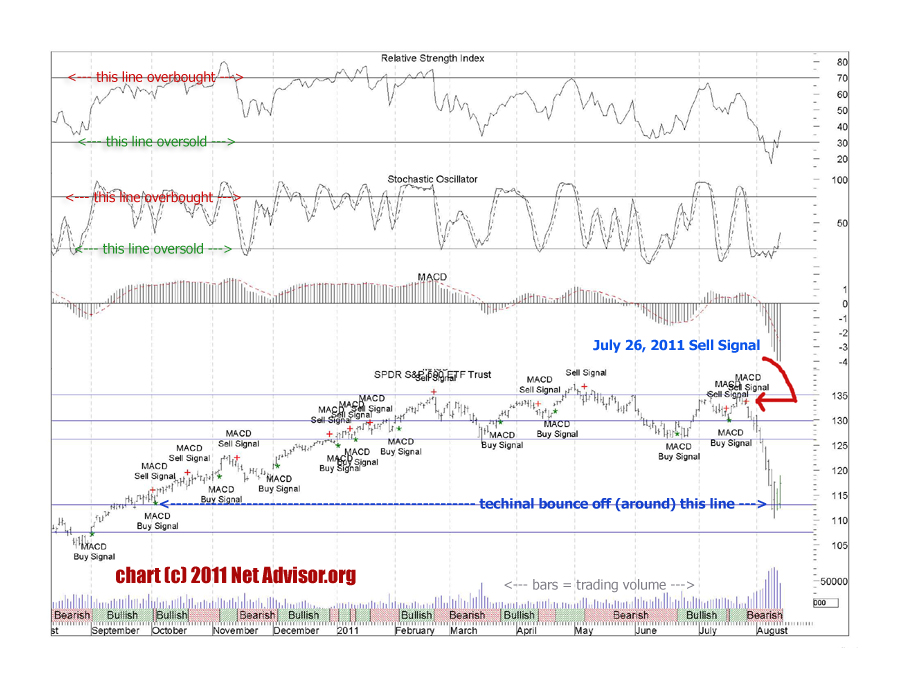08.11.2011

Market Report: Dow Rebounds 423 after Yesterday’s 519 Point Drop
Investor Education Series: Volume II. Issue II.
Original article written by Net Advisor™
Stocks moved up on short covering and bargain hunting on the back of yesterday’s -519 point drop, however economically nothing has changed in the world in the last 24 hours. This is the fourth day where the Dow had traded 400 or more point movement by the close in any direction. We still exercise cautiousness.
Today’s Market Summary
- Dow +423.37 or 3.95% to 11,143.31
- NASDAQ +111.63 or 4.69% to 2,492.68
- S&P 500 Index closed +51.88 or 4.63% to 1,172.64
Commodities
- Crude Oil was up 3% on day two on decreased supply.
- Gold hit new record high to $1,820 before falling after CME raised margin requirements on gold futures contracts. Gold was down 3% from yesterday’s close.
If the CME continues to increase margin requirements sharply higher, the gold trade could be hit harder in the short-run. If the CME does not continue to raise margin requirements, then the gold trade could continue with a bumpy ride in the near term. Something to keep an eye on.
Jobs & The Economy
Jobless claims report came out this morning showing that Initial Jobless Claims fell suggesting that fewer people are filing or taking unemployment claims (Full Report BLS.gov PDF).
What is not being well discussed is that the reason why fewer people are taking unemployment claims is because their unemployment benefits are running out, thus making the report look better than it really is.
As of August 9, 2011 some 491,000 people have run out of unemployment benefits. We’ve been discussing since February 2010 that government is not counting everyone in the unemployment numbers as being unemployed.
In the event someone was frustrated or just otherwise stopped looking for work in the last four weeks, they are not counted as being unemployed. The Bureau of Labor Statistics (BLS.gov) calls this group “marginally attached to the labor force.” By not counting this group as being “unemployed” but who are really unemployed, the unemployment numbers look better than they otherwise should be.
Those who have no more unemployment benefits or lowered incomes have turned to the government food stamp program to get federal money. The number of people on food stamps in the USA hit a new all-time record with 45.8 Million people in the government program or 15% of the U.S. population.
“The number of Americans using the government’s Supplemental Nutrition Assistance Program (SNAP) — more commonly referred to as food stamps — shot to an all-time high of 45.8 million in May, the USDA reported. That’s up 12% from a year ago, and 34% higher than two years ago.”
— Source: CNN, 08-04-2011
This suggests to us that fewer people have money to even buy food. Thus those suffering in the economic down-turn go beyond the official unemployment numbers. The July 2011 unemployment rate went “down” from 9.2% to 9.1% only because more people were not counted as unemployed.
June 2011 BLS.gov Jobs Report (PDF Page 2, Parr 2 – highlight added)
- Number of people not counted as unemployed = 2.7 Million
- Unemployment Rate: 9.2%
July 2011 BLS.gov Jobs Report (PDF Page 2, Parr 4 – highlight added)
- Number of people not counted as unemployed = 2.8 Million
- Increase from June’s BLS Report is 100,000 people were not counted as being unemployed.
- Unemployment Rate: 9.1%
That is how the unemployment rate went “down” in July. Government just didn’t count another 100,000 unemployed workers.
Market Wrap-Up
The markets have gone through a seesaw ride over the last week. It would be surprising for this kind of low-high, high-low volatility to continue beyond the next few trading days or through next week, the market should find some equilibrium.
The challenge is that there are still bank risks and European debt default risks. This has been ongoing for some two years now. Record deficit increases still exist in the USA. Thus there is no evidence that today’s rise in the stock market to suggest that everything is fine now. In our view, these problems are likely to be ongoing through at least 2013-2014.
The upside is that interest rates should remain low through mid-2013 as the FED seems to affirm. The flip side to this is that interest on bank accounts and CD’s will remain low to nil. Also the risk of commodity inflation in food and energy could come back again.
The Dow is likely to have ups and downs based on the data of the day, but it’s hard to call this a “Bull Market” or that there is no recession given all the factual data that’s out there.
__________________________________________________________________________
Disclosure: Net Advisor™ and or clients currently hold long and short positions in S&P 500 Index, and holding a small short gold position all via options that were also discussed in this report.
Credits:
Chart by NetAdvisor.org
Original Content Copyright © 2011 Net Advisor™ All Rights Reserved.
Legal Disclaimer
__________________________________________________________________________

